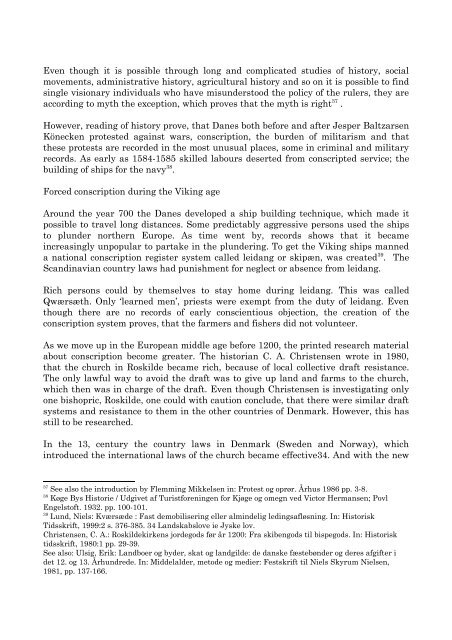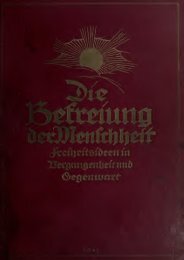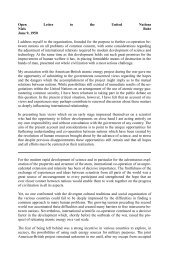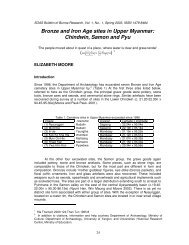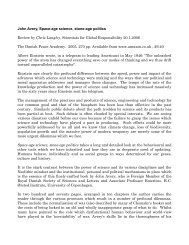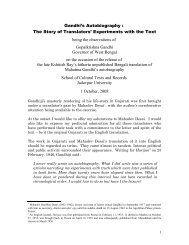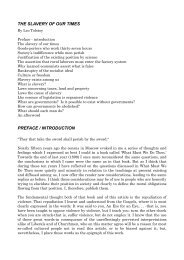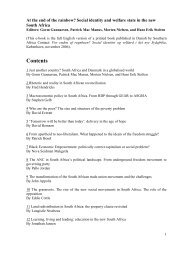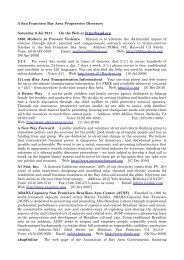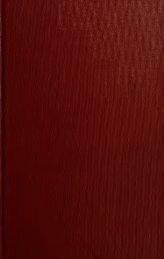Terp, Holger: Danish Peace History - Det danske Fredsakademi
Terp, Holger: Danish Peace History - Det danske Fredsakademi
Terp, Holger: Danish Peace History - Det danske Fredsakademi
You also want an ePaper? Increase the reach of your titles
YUMPU automatically turns print PDFs into web optimized ePapers that Google loves.
Even though it is possible through long and complicated studies of history, social<br />
movements, administrative history, agricultural history and so on it is possible to find<br />
single visionary individuals who have misunderstood the policy of the rulers, they are<br />
according to myth the exception, which proves that the myth is right 37 .<br />
However, reading of history prove, that Danes both before and after Jesper Baltzarsen<br />
Könecken protested against wars, conscription, the burden of militarism and that<br />
these protests are recorded in the most unusual places, some in criminal and military<br />
records. As early as 1584-1585 skilled labours deserted from conscripted service; the<br />
building of ships for the navy 38 .<br />
Forced conscription during the Viking age<br />
Around the year 700 the Danes developed a ship building technique, which made it<br />
possible to travel long distances. Some predictably aggressive persons used the ships<br />
to plunder northern Europe. As time went by, records shows that it became<br />
increasingly unpopular to partake in the plundering. To get the Viking ships manned<br />
a national conscription register system called leidang or skipæn, was created 39 . The<br />
Scandinavian country laws had punishment for neglect or absence from leidang.<br />
Rich persons could by themselves to stay home during leidang. This was called<br />
Qwærsæth. Only ‘learned men’, priests were exempt from the duty of leidang. Even<br />
though there are no records of early conscientious objection, the creation of the<br />
conscription system proves, that the farmers and fishers did not volunteer.<br />
As we move up in the European middle age before 1200, the printed research material<br />
about conscription become greater. The historian C. A. Christensen wrote in 1980,<br />
that the church in Roskilde became rich, because of local collective draft resistance.<br />
The only lawful way to avoid the draft was to give up land and farms to the church,<br />
which then was in charge of the draft. Even though Christensen is investigating only<br />
one bishopric, Roskilde, one could with caution conclude, that there were similar draft<br />
systems and resistance to them in the other countries of Denmark. However, this has<br />
still to be researched.<br />
In the 13, century the country laws in Denmark (Sweden and Norway), which<br />
introduced the international laws of the church became effective34. And with the new<br />
37<br />
See also the introduction by Flemming Mikkelsen in: Protest og oprør. Århus 1986 pp. 3-8.<br />
38<br />
Køge Bys Historie / Udgivet af Turistforeningen for Kjøge og omegn ved Victor Hermansen; Povl<br />
Engelstoft. 1932. pp. 100-101.<br />
39<br />
Lund, Niels: Kværsæde : Fast demobilisering eller almindelig ledingsafløsning. In: Historisk<br />
Tidsskrift, 1999:2 s. 376-385. 34 Landskabslove ie Jyske lov.<br />
Christensen, C. A.: Roskildekirkens jordegods før år 1200: Fra skibengods til bispegods. In: Historisk<br />
tidsskrift, 1980:1 pp. 29-39.<br />
See also: Ulsig, Erik: Landboer og byder, skat og landgilde: de <strong>danske</strong> fæstebønder og deres afgifter i<br />
det 12. og 13. Århundrede. In: Middelalder, metode og medier: Festskrift til Niels Skyrum Nielsen,<br />
1981, pp. 137-166.


